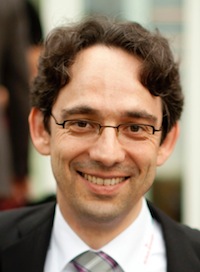

Wind power essential to growing renewable energy industry

The World Wind Energy Association, headquartered in Bonn, Germany, is an international non-profit organization that works for the promotion and deployment of wind energy technology worldwide. The organization has members in 95 countries and has a special consultative status at the United Nations. We spoke with the organization's president, Mr. Stefan Gsänger, to learn more about why wind energy is becoming more popular, what some of the current global trends are and what projects the WWEA is currently working on.
GSC: Wind power has seen a steady increase in popularity in recent years, as more and more countries become interested in harnessing this renewable energy. What makes wind power such a desirable source of energy in comparison to other renewable energy sources?
Stefan Gsänger: Wind power, in particular onshore wind, is today the cheapest option to generate electricity, when compared to new investment. Wind is now cheaper than gas, oil, even coal and certainly nuclear power, even without taking into account externalities like climate change, air pollution, or nuclear contamination. This economic advantage was recognised by many scientists and economist quite a while ago, and most recently also by an increasing number of governments and authoritative international organisations. Also in comparison with other renewable technologies, onshore wind is still by far the cheapest option. Of course wind power has a volatile character, and this is where other renewable sources can play their role and generate higher revenues. This relation defines also the future role of the different technologies: Wind power should always be used whenever the wind is blowing, and other technologies, including storage options, will deliver, at higher cost, when there is no wind.
GSC: One specific area of focus for your organization is that of small wind, which refers to smaller-scale wind turbines generating 100kW or less. Why is this a particular area of interest for your organization? How has the market for small wind turbines developed in recent years?
Stefan Gsänger: Wind technology is diversifying more and more: on the one hand, we see a growth in size and capacity of large wind turbines which feed into public grids. Simultaneously, there is also an increasing demand for small wind turbines. The global growth rate has been around 20 percent, thus exceeding the growth in large wind turbines. Many of the almost one million small wind mills installed around the world are used for rural electrification. Small wind energy can contribute to bringing electricity to unserved areas at competitive cost. But although the small wind market has grown very dynamically, we still see three major challenges: We need more mass production in order to further decrease cost, we need to make sure that sound quality standards are in place, and, thirdly, to achieve these goals, we need supportive policies in place. WWEA has established a small wind section with a focus on these areas.
GSC: Currently, China leads the world in the number of new turbines added annually in the area of windpower total capacity. Why is wind power seen as such a desirable investment in China? What other trends have you seen across global markets in terms of which countries are investing in wind power most heavily?
Stefan Gsänger: China has indeed invested massively in wind power and built a complete supply chain within only few years. The country has started an energy revolution, and within a quite short period of time the country has become the world leader not only in wind but in many renewable technologies. There are mainly four reasons. First, environmentally: The air pollution in the country has reached a level which cannot be tolerated any more. China also sees itself committed to contributing to climate change mitigation. But of course, secondly, scarcity of fossil resources is also forcing China onto the renewable energy path. Thirdly, China has understood the great prospects of a renewable energy industry which can create millions of jobs, for domestic demand but also as an export industry.
Before this background, it is very encouraging to see that last year for the first time ever China invested more in renewable than in conventional power generation.
Besides China, the traditionally strong wind markets used to be in Europe and in North America. However, recently new wind markets are coming up, in particular in Latin America and most recently also in Africa. Simultaneously, the wind markets of many OECD countries have slowed down or even collapsed, like in the USA. The European Union, over many years the leading wind power region, will be overtaken this year by Asia as the continent with the largest total installed wind capacity. This is mainly due to a lack of political support in these countries, the fossil lobby is pressurising these governments very strongly. Such resistance doesn't exist to the same degree in most "developing" countries, hence we expect that in the mid-term, the most dynamic wind markets will be in Asia, Latin America and Africa. China is about to become the technology provider for these countries, and Europe is about to loose its pole position.
GSC: What are some current projects the WWEA is working on to help advance wind power globally?
Stefan Gsänger: Primarily, WWEA aims at promoting wind power by providing information about wind power. We are enabling the wind community from around the world to exchange their experience, and we are informing governments and everybody who is interested with data about the status of wind power in the world. We do this with different publications, like our biannual yearbook Wind Energy International, our annual World Wind Energy Reports, our Quarterly Bulletin etc. We are also involved in organizing events and trade fairs, e.g. our annual World Wind Energy Conference (the WWEC2014 just took place in Shanghai) and our World Summit for Small Wind.
WWEA works in many different areas, but I would like to highlight in particular two: WWEA finds its especially important to encourage local citizens, i.e. community type investors, as local communities are key for the social acceptance and support for wind power deployment. In parallel, WWEA has launched, together with partners from civil society, industry and science, a global campaign for a global 100 percent renewable energy supply. The purpose of this campaign is to create awareness that a 100 percent renewable energy supply is possible and that ways and strategies towards this goal should be discussed on a very broad level. On the campaign website, everybody can find examples of communities and regions who have already managed to reach this goal. Wind power plays a key role in many of these cases, hence we find these examples very important and inspiring.
GSC: Thank you very much for your time, Mr. Gsänger.
More Information: www.wwindea.org
